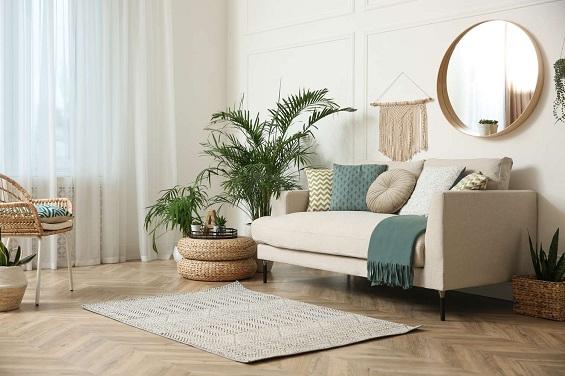Minimalism has become a popular design trend, offering a clean, clutter-free aesthetic that promotes simplicity and tranquility in the home. Designing a minimalist home requires careful consideration of every element to achieve a harmonious and balanced space. In this article, we will explore key things to avoid when designing a minimalist home, ensuring that you create a serene and functional environment that embraces the essence of minimalism.
You may also love these : How to Create a Minimalist Home All by Yourself in No Time

Mistakes to Avoid When Designing a Minimalist Home
Clutter and Excessive Decor:
One of the fundamental principles of minimalism is the elimination of unnecessary clutter. Avoid overcrowding your space with too many decorative items, excessive furniture, or unnecessary accessories. Instead, focus on a few well-chosen, high-quality pieces that serve a purpose and contribute to the overall aesthetic of simplicity.
Busy Patterns and Loud Colors:
Minimalism thrives on a neutral color palette and clean lines. Avoid using busy patterns or loud colors that can disrupt the calm and balanced atmosphere. Opt for a subdued color scheme with shades of white, beige, gray, or pastels to create a serene backdrop. Introduce pops of color sparingly, if desired, to maintain the minimalist aesthetic.
Lack of Storage Solutions
A clutter-free home requires proper storage solutions. Avoid neglecting storage needs in your minimalist design. Incorporate smart storage solutions such as built-in cabinets, hidden storage compartments, or minimalist shelving systems. This allows you to maintain a tidy space by keeping belongings out of sight, promoting an uncluttered environment.
Oversized Furniture
When designing a minimalist home, avoid oversized furniture that overwhelms the space. Opt for sleek and appropriately scaled pieces that fit the room’s proportions. Choose furniture with clean lines and simple designs to maintain the minimalist aesthetic. Allow for ample negative space to create an open and airy atmosphere.
Lack of Functional Design
Minimalism emphasizes functionality and purpose. Avoid sacrificing functionality in favor of aesthetic appeal alone. Ensure that each piece of furniture and decor serves a practical purpose in your daily life. Strive for a balance between functionality and visual appeal to create a space that is both beautiful and practical.
Insufficient Lighting
A well-lit space is essential in minimalist design to create a sense of openness and clarity. Avoid insufficient lighting that can make the room feel gloomy or cramped. Embrace natural light as much as possible by using sheer curtains or blinds. Additionally, incorporate a combination of ambient, task, and accent lighting to enhance the overall ambiance of the space.
Neglecting Negative Space
Negative space, also known as white space or empty space, is a crucial element of minimalist design. Avoid overcrowding your space and allow for sufficient negative space to create a sense of calm and balance. Negative space provides visual breathing room and allows the eye to rest, highlighting the key elements in your minimalist home.
Disregarding Texture and Materials
Minimalism doesn’t mean a complete absence of texture or materials. Avoid overlooking the importance of incorporating different textures and materials in your minimalist design. Introduce elements such as natural wood, textured fabrics, or smooth metals to add depth and visual interest to your space. These subtle variations in texture create a sensory experience without overwhelming the minimalist aesthetic.
Lack of Personal Touch
While minimalism promotes simplicity, it should still reflect your personal style and taste. Avoid creating a sterile or impersonal environment by incorporating elements that add a personal touch. Display a few carefully chosen meaningful items, such as family photographs, artwork, or sentimental objects, to infuse warmth and personality into your minimalist home.
Neglecting the Sense of Warmth
Minimalist design can sometimes be perceived as cold or sterile. Avoid this by introducing elements that create a sense of warmth and coziness. Add soft textiles like rugs, throws, or cushions to create a welcoming atmosphere. Consider incorporating natural elements such as plants or organic materials to bring life and warmth to your minimalist space.
Overlooking Functional Storage
In a minimalist home, storage is essential to maintain a clutter-free environment. Avoid the mistake of neglecting functional storage solutions. Incorporate storage options such as hidden cabinets, built-in shelves, or multi-purpose furniture with concealed compartments. By having designated spaces for organizing your belongings, you can keep surfaces clear and maintain the minimalist aesthetic.
Lack of Cohesion in Materials and Textures
Achieving a cohesive and harmonious look is essential in minimalist design. Avoid the mistake of incorporating materials and textures that clash or disrupt the overall aesthetic. Choose materials and textures that complement each other, creating a sense of visual unity. For example, pairing natural wood with clean lines, smooth metals, or textured fabrics can create a balanced and visually appealing composition.
Disregarding the Importance of Lighting
Lighting plays a crucial role in setting the tone and mood of a minimalist space. Neglecting proper lighting can result in a lackluster atmosphere. Avoid this mistake by incorporating a variety of lighting sources. Use a combination of natural light, ambient lighting, task lighting, and accent lighting to create layers of illumination and enhance the overall ambiance. Consider installing dimmers to adjust the intensity of the lighting to suit different occasions.
Designing a minimalist home is a delicate balance of simplicity, functionality, and aesthetic appeal. By avoiding clutter, excessive decor, busy patterns, oversized furniture, and neglecting storage solutions, you can create a serene and uncluttered environment. Embrace a neutral color palette, sufficient lighting, negative space, and a touch of personalization to add depth and warmth to your minimalist home. With careful attention to these considerations, you can design a space that embodies the essence of minimalism while reflecting your unique style and creating a peaceful haven.





